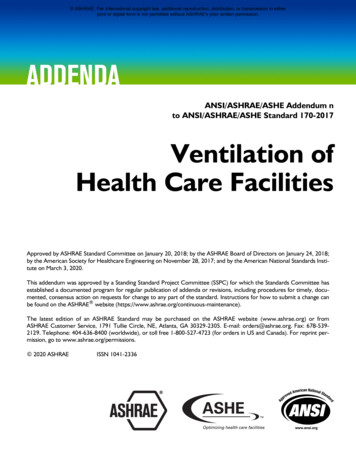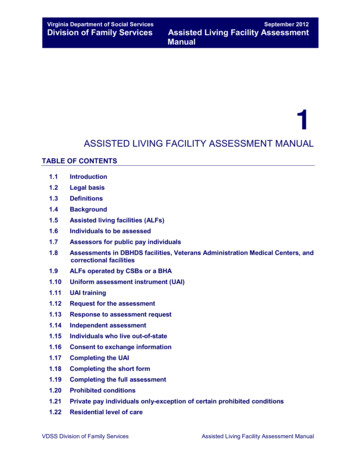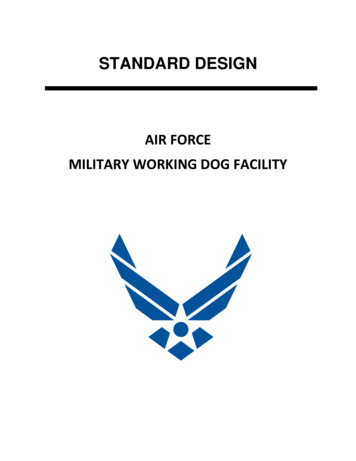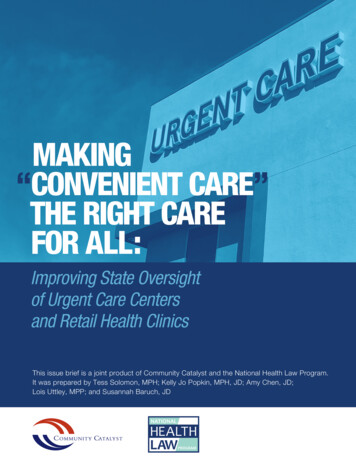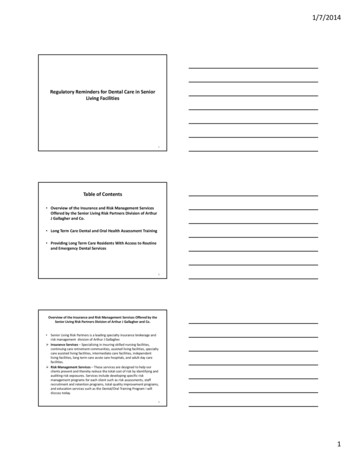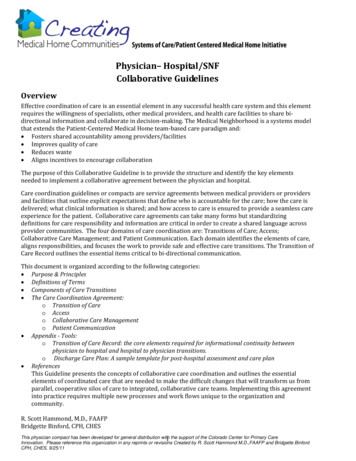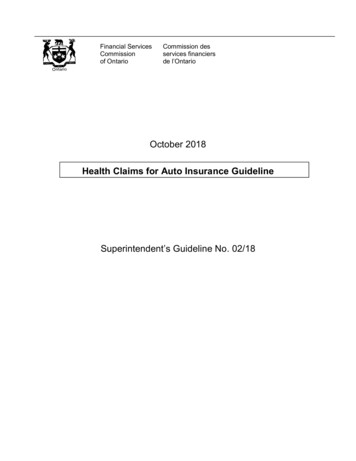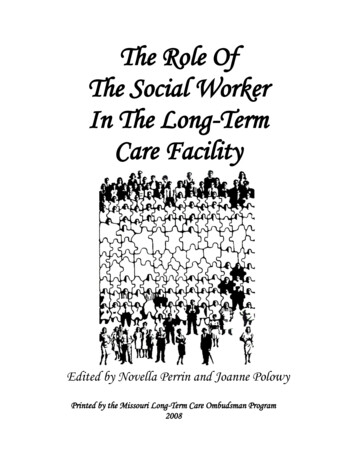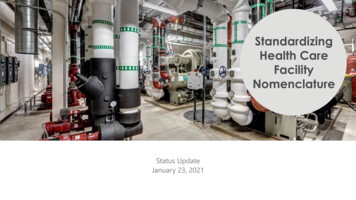
Transcription
StandardizingHealth CareFacilityNomenclatureStatus UpdateJanuary 23, 2021
BuildingsHealth Care FacilityNomenclatureWhat is being standardized?Benchmarking,Cost of Ownership, EUIAlignment betweenFGI Facility Types andEPA Property TypesClassification for buildings and theirfunctional elements.––Use of recognized industry standards.Alignment with regulatory frameworksgoverning healthcare facilities management.Why?Provide planners, designers, and operatorswith a common nomenclature.––––Simplify the maintenance of reliable buildingmaster records.Simplify and streamline health care facilityrisk management.Increase compliance with regulatoryrequirements.Support benchmarking/increase visibility intototal cost of ownership.Systems- Condition- Capacity- Risk MgtFunctionalAreas- Patient Care Acuity- Risk ManagementSpaces- Space Use- LocationsAssets- ITM History- ComplianceAlignmentwith FGI andASHRAE 170Alignment withUniformat, NFPA,CMS2
Background The Health Care Facility Nomenclature effort started as a grassrootsinitiative by several health care facility management organizationsto standardize the classification of buildings, building systems andspaces. A first draft of the classification standards was published in January2021 by the American Society for Healthcare Engineering (ASHE)and the Facility Guidelines Institute (FGI).–Categorization schemasaligned with the FGI 2018 Guidelines for Design and Construction of Hospitals1) Categorization of Buildings2) Categorization of Functional Areas3) Categorization of SpacesThese three classification schemas are draft versions that have been submitted for consideration to the SteeringCommittee of the FGI Health Guidelines Revision Committee (HGRC). A final version will be published in 2021 oncethe review of the Steering Committee is complete.–This article describes the genesis of the data ategorization schemasaligned with UniFormat , adjusted by ASHE for health care facility engineering4) Categorization of Building Systems5) Categorization of AssetsThese classification schemas are draft versions that have been submitted for consideration to the OperationalExcellence Committee of ASHE. A final version will be published in 2021 once the review of the OperationalExcellence Committee is complete."3
The 5 Health Care Facility Management Nomenclatures/ClassificationsBenefits of StandardizationStrategicBuildingsStandardized list of health care building types.Increased reliability of real estate portfolio registerIncreased reliability of benchmarking dataWith clarified measurement of Gross and Net Square Footages.BuildingSystemsStandardized listof functionalelements neededto operate ahealth care facility.BuildingSystemAssetsStandardized listof maintainableequipment used inhealth carefacilitiesengineering.FunctionalAreasIncreased quality of infrastructure condition, risk andresiliency assessments.Standardized listof functional unitsneeded in thedelivery of healthcare.Improved alignment between clinical service delivery andfacilities.SpacesStandardized listof spaces (rooms,areas) found in ahealth care facility.Increase Efficiency of Maintenance & Operations Function OperationalImprove quality and impact of engineering asset register and the inspection,testing and maintenance programSupport informed capital investments, to increase reliability of criticalinfrastructure and reduce operating costOptimization of Space Management Function Optimize space utilization, service delivery, clinical planning and billing4
Classification ofBuildingsAligned with–EPA Property Types Alignment with EPA Portfolio Manager Alignment with ASHE Energy-to-CareBenchmarking–FGI Facility Types5
Functional Areasand SpacesFGI Requirements for Nomenclature1.2-2.1.3 Nomenclature in the Functional Program1.2-2.1.3.1 The names for spaces and departments used in the functionalprogram shall be consistent with those used in the Guidelines for Designand Construction of Hospitals. If acronyms are used, they shall be clearlydefined.1.2-2.1.3.2 The names and spaces indicated in the functional programalso shall be consistent with those used on submitted floor plans.1.2-3 Space ProgramA space program shall be provided that contains a list organized bydepartment or other functional unit that shows each room in theproposed project, indicating its size by gross floor area and clear floorarea and citing relevant paragraph number(s) from this document.6
Classification ofFunctional AreasAligned with the structure of the FGI“Guidelines for Design and Constructionof Hospitals”7
Classification of SpacesAligned with the FGI “Guidelines for Design and Construction of Hospitals”8
Building Systems and AssetsOne-line drawingsare being developedfor each buildingsystemAsset Categories areshown on the oneline diagram9
Building SystemsThis classification is designed toitemize building infrastructure intofunctional elementsto support activities such as risk management, capacityplanning, condition assessments.Aligned with– CSI Uniformat 2010– Healthcare FM regulations or references (CMS, NFPA,FGI)– Accreditation agencies such as TJC10
AssetsThe classification system groupsactivities such as preventivemaintenance, regulatory monitoringand cost allocation to be alignedwith the organizations assets.Assets in this context are defined as tangible resources(building, system, equipment) that requires documentedinspections, testing and maintenance.Aligned with– CSI Uniformat 2010– Healthcare FM regulations or references (CMS, NFPA,FGI)– Accreditation agencies such as TJC The schema lists 640 categories of assets that are typicallymaintained by the engineering team of a healthcare organization. Each category is defined, and has references to Uniformat 2010,OmniClass Table 21 and where applicable to regulatory codes andstandards. The Construction Specification Institute licensed the use ofUniformat 2010 for this classification schema.11
Putting the Standards to Work: An Example in Risk ManagementFuel SystemCentral HeatingCentral CoolingHydronic DistributionSteam DistributionElectrical PowerDistributionIntegrated AutomationFacility ControlsAHU 1Criticality of Functional AreasRisk Likelihood of Failure xImpact of FailureInfrastructure Condition, Redundancy and Resiliency12
Get involved!To get involved, contact Matthias Ebinger (mebinger@enstoa.com)or Frank Rudilosso (frr9035@nyp.org).
– CSI Uniformat 2010 – Healthcare FM regulations or references (CMS, NFPA, FGI) – Accreditation agencies such as TJC. 11 Assets The schema lists 640 categories of assets that are typically maintai



